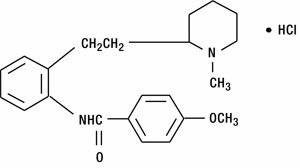Enkaid
Generic name: encainide hydrochloride
Dosage form: Capsules
Medically reviewed by Drugs.com. Last updated on Mar 22, 2022.
On This Page
Enkaid Description
Enkaid® (encainide hydrochloride) is an antiarrhythmic drug supplied as 25 and 35 mg capsules for oral administration. The chemical name of Enkaid is (±)-4-methoxy-N-[2-[2-(1-methyl-2-piperidinyl)ethyl]phenyl] benzamide monohydrochloride. Its molecular weight is 388.94 and the structural formula is represented as follows:

Encainide hydrochloride is a white solid which is freely soluble in water, slightly soluble in ethanol, and insoluble in heptane. The pH of a 1% aqueous solution is 5.8. In addition to the hard gelatin capsule shell, the other inactive ingredients are lactose, magnesium stearate and sodium starch glycolate.
Enkaid - Clinical Pharmacology
Mechanism of Action
The mechanisms of the antiarrhythmic effects of Enkaid are unknown but probably are the result of its ability to slow conduction, reduce membrane responsiveness, inhibit automaticity, and increase the ratio of the effective refractory period to action potential duration. Enkaid produces a differentially greater effect on the ischemic zone as compared with normal cells in the myocardium. This could result in the elimination of the disparity in the electrophysiologic properties between these two zones and eliminate pathways of abnormal impulse conduction, development of boundary currents and/or sites of abnormal impulse generation.
Electrophysiology
Enkaid is a Class IC antiarrhythmic agent, ie, is a blocker of the sodium channel of Purkinje fibers and the myocardium.
In isolated Purkinje and myocardial cells its electrophysiologic profile is characterized by a dose-related slowing of phase 0 depolarization and little effect on either the action potential duration or repolarization. This profile differs from that of Class IA drugs (eg, quinidine, disopyramide, procainamide) that slow phase 0 depolarization and prolong action potential duration or Class IB agents (eg, lidocaine, tocainide and mexiletine) that slow phase 0 depolarization only slightly and shorten the action potential duration.
In the intact animal and man, the electrophysiologic effects of encainide are a result not only of encainide but of two metabolites as well, each of which is present in most patients (over 90%) at therapeutically activ...



